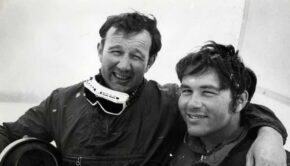Hard innovation
Published on October 18th, 2023
For North Americans in the upper continent, winter is welcomed by those that play in the cold, and iceboaters have been tuning their equipment since the ice last thawed. In the October 2023 issue of Seahorse Magazine, Dobbs Davis provides a view of sailing on the hard:
While foiling technology has brought high-speed sailing closer to our consciousness in the soft-water sailing world, at this time of year for more than a century this has started to come into focus for those who compete on hard water… iceboating.
Many are involved in the largest class of iceboats, the DN class, founded in 1937 from a design contest sponsored by the Detroit News newspaper. The contest sought an affordable design that was not only fast but buildable either commercially or at home.
After decades of innovation these principles still apply for DNs, keeping the class active and relevant for hundreds of enthusiasts both in northern Europe and the northern US and Canada. Innovators like Ron Sherry at Composite Concepts in Clinton, Michigan continue to tweak their designs to be just a little faster on hardwater at speeds of 60kt and above – lying prone in the fuselage a few centimeters above the ice.
At the DN Gold Cup in Finland in 1998, perennial DN champion Sherry was clocked at just over 90mph.
Yes, ‘fuselage’ is the official term for what would be called a hull on soft water and, needless to say, there are definitions and limitations to its dimensions in all directions. Inspired by trends in the extremely competitive Baltic DN fleets, Sherry has been among those most active in exploring these parameters.
There is a strong cooperation between the keen members of the North American fleet (perennial champions like Ron, Steve Orlebeke, Matt Struble, and others) and fleets in the Baltic (a household name here would include America’s Cup skipper Karol Jablonski, another perennial DN champion), with the two groups not only sharing ideas and time on the ice but keeping sailing gear in both locations.
This is especially important when you consider the inherently itinerant nature of iceboat competition, where choosing a date and location is always approximate until the weather allows for suitable ice conditions as well as wind… it’s not uncommon to have to drive many hundreds of miles to an agreed location with only a day’s notice. Major championships usually have agreed advance dates and approximate locations that get refined closer to the event.
Some carbon is allowed in DN construction but class rules dictate it is combined with more natural composites like Sitka spruce, mahogany, and okoume, with unidirectional S-glass reinforcement, all bonded with West System’s epoxy.
West System’s founder Jan Gougeon, a similarly virulent iceboater in Bay City, Michigan, explains: “To reduce windage drag we now build the fuselage with about 5cm more depth so you can be lower in the boat for better boom clearance without losing the advantage of minimizing drag. This helps optimize the aero end-plate effect from the sailplan but also helps us older guys remain competitive…”
Sherry has four more fuselages to build for this winter, usually customized to fit the owner’s preferences and dimensions. This flexibility is another enduring attraction of DN iceboats: unlike similar-sized classes of boats that race on soft water, there is not a strong type-forming for an ideal sailor size, or age, or gender.
Sherry specializes not only in fuselage construction, but all components, including composite masts, runners, planks, and hardware. He is a five-time World, 14-time North American, and five-time European Champion in the class, but retains the same philosophy of cooperation.
Share knowledge with all sailors, “because the faster they are the faster I will be. Fast is fun.” He has built 250 fuselages, over 1,000 masts and planks, and some 3,500 runners of all types.
Sherry explains that like the ‘ageing’ Snipe dinghy, which has been successful at attracting young talent and staying relevant for high-level competition like the Pan Am Games, there is a strong spirit of inclusiveness in the DN class too: all are encouraged to compete.
“Jan and I were having a beer at the Pink Pony after the Mac race,” he said, “and a young guy came over and explained how he was going to kick our asses in iceboats. We looked at each other and had the same reaction: ‘Please come out and have a go’, we said. ‘We’ll help in any way we can’. I think we caught him off-guard!”
For young bucks like this to keep up with their elder peers, there are numerous variables to navigate where only experience and not a fixed recipe will yield results. These include sail choice – rules allow you to register two for an event – and blade preferences based on ice conditions.
“It takes years to figure out the best blade to use,” explains Steve Orlebeke. “There are variations in blade length, thickness of the steel, the fore and aft crown angle at the bottom of the blade, and sharpness – you want it just sharp enough to prevent leeway but not too sharp either.”
Orlebeke is director of engineering at Harken, where being in Wisconsin there is a long history of iceboat enthusiasm, particularly in the Skeeter class, of which he is Class President. The International E Skeeter also dates from the late 1930s but was founded as a development class, with only one rule limitation: a maximum 75ft² sail size. Accordingly, E Skeeters are the fastest things on ice.
All hail to those who will venture forth in the next few months of winter in search of good ice!
To learn about subscribing to Seahorse Magazine, click here.









 We’ll keep your information safe.
We’ll keep your information safe.